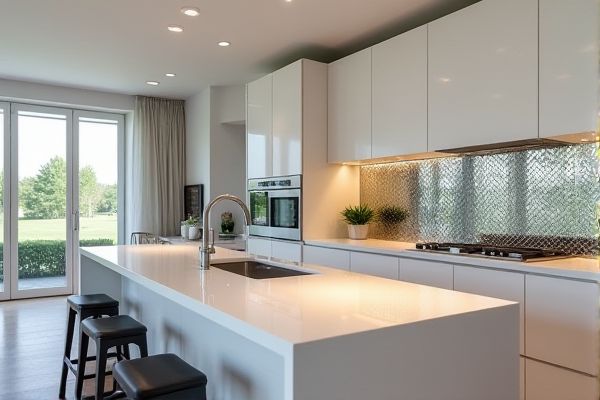
A mirrored backsplash offers a reflective surface that visually expands your kitchen and enhances light, while a glass backsplash provides a sleek, easy-to-clean option with customizable colors and patterns to suit your style. Discover which backsplash best fits Your kitchen design and functional needs by reading the rest of this article.
Table of Comparison
| Feature | Mirrored Backsplash | Glass Backsplash |
|---|---|---|
| Material | Reflective mirror glass | Tempered colored or clear glass |
| Appearance | Highly reflective, creates illusion of space | Smooth, sleek, customizable colors and textures |
| Maintenance | Prone to fingerprints and smudges; requires frequent cleaning | Easy to clean; resists stains and moisture |
| Durability | Fragile; can chip or crack easily | Highly durable due to tempered glass |
| Installation | Requires precise handling; professional recommended | Simple installation; can be customized to size |
| Price | Moderate to high cost | Varies from affordable to premium depending on customization |
| Style Impact | Brightens kitchen; modern and elegant style | Versatile; complements modern and traditional designs |
Introduction to Mirrored and Glass Backsplashes
Mirrored backsplashes create a reflective surface that enhances light and space, making kitchens appear larger and brighter. Glass backsplashes offer a sleek, smooth finish with versatile color and texture options, providing easy maintenance and durability. Both materials serve as stylish, modern design elements that protect walls from spills and splashes while elevating kitchen aesthetics.
Key Differences Between Mirrored and Glass Backsplashes
Mirrored backsplashes feature reflective surfaces that enhance light and create the illusion of space, while glass backsplashes offer a sleek, transparent or colored finish that is easy to clean. Mirrored options tend to showcase fingerprints and smudges more visibly, whereas glass can incorporate various textures and patterns for design flexibility. Both materials provide durability and heat resistance, but mirrored backsplashes excel in adding brightness, and glass backsplashes excel in stylistic versatility.
Aesthetic Appeal: Mirrored vs Glass Backsplashes
Mirrored backsplashes provide a sleek, reflective surface that enhances kitchen brightness and creates an illusion of expanded space, making them ideal for modern, minimalist designs. Glass backsplashes offer versatility with various colors, textures, and finishes, allowing for personalized aesthetic appeal and easy integration with different kitchen styles. Both options deliver a contemporary look, but mirrored backsplashes emphasize light and openness, while glass backsplashes focus on color richness and design flexibility.
Durability and Maintenance Comparison
Mirrored backsplashes offer high durability with scratch-resistant surfaces and easy cleaning using glass-safe products, maintaining a sleek, reflective finish that resists stains and heat. Glass backsplashes, while also durable and heat-resistant, may require more frequent maintenance to prevent smudges and water spots, especially in high-use kitchen areas. Your choice depends on preferred appearance and how much time you want to invest in upkeep, but both materials provide long-lasting and stylish protection for kitchen walls.
Light Reflection and Space Enhancement
Mirrored backsplashes maximize light reflection, creating a brighter kitchen environment by bouncing natural and artificial light throughout the space. Glass backsplashes offer a sleek, reflective surface but tend to diffuse light more softly, enhancing ambiance without the intense brightness of mirrors. Choosing a mirrored backsplash can significantly amplify your kitchen's sense of space and openness, ideal for smaller or darker areas.
Cost Analysis: Mirrored vs Glass Backsplash
Mirrored backsplashes typically cost between $50 to $150 per square foot, influenced by the quality and thickness of the glass used, while standard glass backsplashes range from $40 to $100 per square foot depending on customization and installation complexity. Installation of mirrored backsplashes may require specialized labor due to the fragility and reflective properties, potentially increasing overall expenses by 10-20%. Budget considerations for glass backsplashes benefit from greater variety in pricing, as tempered glass or custom designs can elevate costs compared to straightforward mirrored panels.
Installation Process and Complexity
Mirrored backsplashes require precise cutting and careful handling to avoid cracking, often needing professional installation due to their fragility and reflective surfaces. Glass backsplashes, while also delicate, tend to be easier to install with standard adhesives and are available in tempered options for added durability. Your choice depends on whether you prioritize the sophisticated look of mirrors or the straightforward installation and resilience of glass.
Cleaning and Upkeep Requirements
Mirrored backsplashes require frequent cleaning to prevent fingerprints and smudges from diminishing their reflective quality, making a streak-free glass cleaner essential for maintenance. Glass backsplashes are easier to maintain with less frequent cleaning, as they resist staining and are less prone to showing streaks or smudges. Your choice should consider the time and effort you're willing to invest in upkeep to keep your backsplash looking pristine.
Best Kitchen Styles for Each Backsplash Type
Mirrored backsplashes complement modern and contemporary kitchens by enhancing light and creating the illusion of space, making them ideal for sleek, minimalist designs. Glass backsplashes offer versatility with customizable colors and patterns, fitting well in transitional and traditional kitchens where color coordination and easy maintenance are priorities. Both options boost kitchen aesthetics but should be matched with the overall style to maximize visual impact and functionality.
Pros and Cons of Mirrored and Glass Backsplashes
Mirrored backsplashes create a spacious, light-enhancing effect ideal for small kitchens but can show smudges and require regular cleaning due to fingerprints and cooking splatter. Glass backsplashes offer versatile design options with customizable colors and textures, provide easy maintenance, and resist heat and moisture, yet they may chip or crack if subjected to heavy impact. Both materials enhance modern kitchen aesthetics, with mirrored surfaces emphasizing brightness and depth while glass prioritizes durability and design flexibility.
 homyna.com
homyna.com